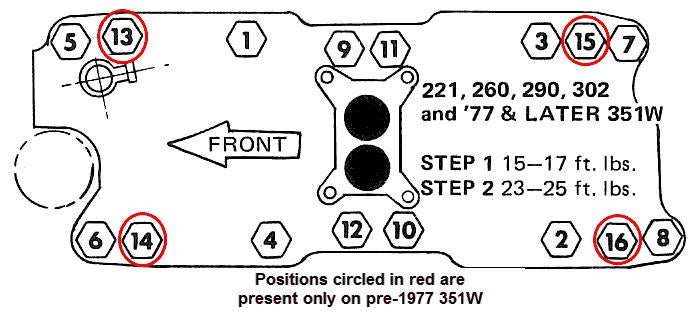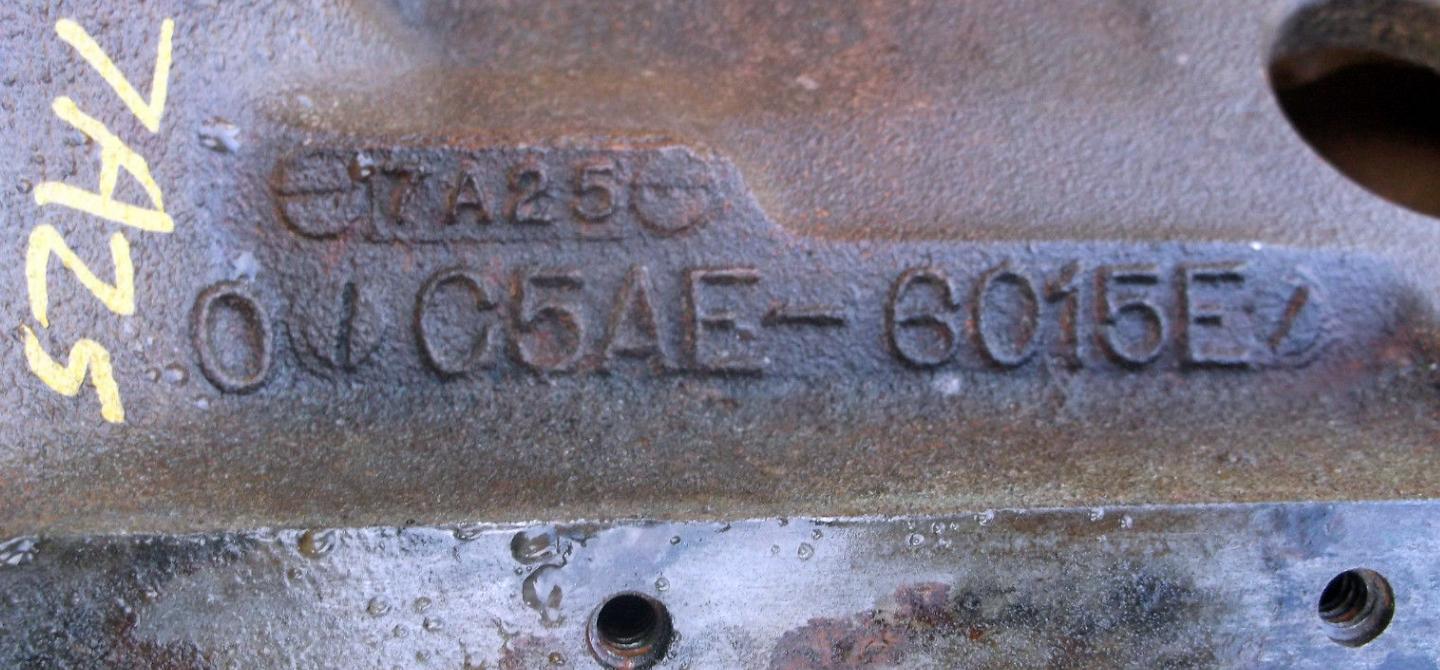The 351W uses a larger main journal than the 302. There are 2 physical ways of telling a 302 vs. Also, in between the frost plugs on a 351W there will be what appears to be a triangle or diamond (the way I was told) indented cast into the block.a 302 doesn't have those. This was the only 351 for that year with the adjustable rocker arms from the factory. According to my reference book the D0AE-L casting number was a non-hipo Cleveland block available in both the 1970 and 71 model years. The casting numbers for the Boss 351 blocks were D1ZE-A and D1ZE-B and were 4 bolt mains.
221, 260, 289, 302The 221, 260, 289 were originally designed for the Fairlane and produced only in the Cleveland engine plant from 1962-1965. The 1964 289 casting number for all 289s was C4OE-6015-C (later an F suffix). In 1965, this number was changed to C5AE-6015-E for the 289 2V, 4V and Hi-Po (note the change to full size Ford designation and 6 bolt bell housings). In mid-year 1966 the Windsor plant also began producing 289s. The casting numbers for these were (C6AE-6015-C with a '289' and 'WF' in the lifter valley. In 1967 both Cleveland and Windsor produced 289s using earlier year casting numbers but with updated date codes. These two blocks were interchangeable, but there were probably some minor differences. Near the end of the 1967 production run, Cleveland ran out of 289 blocks and substituted their new 302 block, C8-OE-6015-A and marked with 302 in the lifter valleys. This block wasn't intended to see action until 1968. Note these 302 casting numbers returned to the intermediate size Ford or Fairlane lineage. Hence, a late model 289 coming from the Cleveland plant might have a 302 block with 289 innards. The Windsor plant had an abundance of 289 blocks for 1967. In 1968 Cleveland only made 302s, while Windsor continued with the 289s. It appears Windsor also tooled up for 302s but the plug was pulled before they got to make any. They did however, design and produce a 302 block that was used on 289s after the stock of 289 blocks was depleted. The number was C8AE-6015-B with 302 marking in the lifter valley. At the very end of the model year some additional 289 blocks must have been discovered as the older C6AE-6015-C blocks appeared again. In 1969 Cleveland continued with 302 production. Windsor dropped 289 production and took up the 351. In 1970 Cleveland came out with its newly designed 351. In short: C8OE-6015-A is a 302 block from Cleveland from a 1967 289 or a 1968 or later 302 (check date code). There is no code stamped on the block itself that can be used to identify the cubic inch displacement of the block. Casting numbers can be helpful, but some blocks used several different casting numbers, and in some cases, one casting is not interchangeable with the other. Engines are identified by a tag attached to the engine. This tag is used on all late 1964-1970 models and located under the coil attaching bolt. On the tag is the displacement, assembly plant, model year, change level, engine code (useful in identifying high performance engines) and date of production. This tag is easily lost or replaced with a fake tag, so don't rely solely on the tag for identification. Cylinder HeadsCasting numbers for cylinder heads may change from year to year. For example, the code may be cast as C6ZZ-A in 1966 and C8ZZ-A in 1968 even though they are the same cylinder head. Special heads are required with emission controls from 1965-1966 for the emission system to operate properly. Beginning in 1967, all heads have provisions for emission control systems. Casting numbers are usually the same or nearly the same as the part number. Cylinder heads cast with a '5' as the second digit were most likely installed in a 1966 model. | Pictures courtesy of Cruce Motor Rebuilding
The casting number is located where the starter bolts up to the bell housing. Removal of the starter is necessary to see the number 390FE V-8 Big Block The casting number is located where the starter bolts up to the bell housing. Numbers can be horizontal or vertical. In some cases, they are not there at all! 1965 model 289 Head Head casting number is under the cylinder head. 1965 model 289 Head Date code location is under the valve cover. |


Ford 351 Windsor Engine Identification
Ford kept track of the various parts and castings in its inventory by assigning each item its own unique alphanumeric identification number. These numbers provide a lot of information to those who are familiar with what the numbers mean. The unique identifier is a series of numbers and letters that are put in a specific sequence, and the location of the digit determines what that digit designates. Information commonly provided by part numbers includes the decade during which the part was designed or manufactured, the year of the decade the part was designed or manufactured, the car line the part was originally designed for, the engineering department originally responsible for the design, the basic part number, and the changes made to the original design.
What can be confusing about these numbers is that a part designed for one year might actually be used for several years, or a part designed for one car line might be used on other lines as well. For instance, a part originally designed for a 1964 Ford could often be found on a 1964 or 1965 model Thunderbird, Mercury, or Lincoln as well. It is actually quite common to find parts originally designed for Thunderbirds on Lincolns, and Falcon parts on Mustangs. In order to spread out the costs of designing and manufacturing a part, Ford used parts on different models.


Ford 351 Serial Number Location Number
The Ford part number on the box shown at left is on the top line: B8A-9431-A. Other information indicates it was an Engine Engineering Division design, weighs 9 pounds, provides information on the quality control inspection, and the date packed.